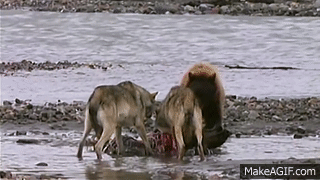Grizzly bears and wolves have coexisted for millennia — but when food is scarce, these two apex predators must fight to survive.

Grizzly bears and wolves are both native to North America, sharing similar wilderness habitats across the Northwestern-most states, including Montana, Wyoming, and Washington. Harsh environments often result in food scarcity, and the predators are forced to compete over prey.
A carcass on the side of a river makes the perfect scavenged meal — appealing to both species of hungry predators.

Wolves are social animals, hunting mostly in packs. They prefer to work together to conquer larger mammals, including moose and bison. Bears live more solitary lives, although alone they are capable of taking down equally enormous prey.
The full-grown gray wolf weighs nearly 100 to 150 pounds and has a bite capacity that can deliver 1,000 to 1,500 pounds of pressure per square inch. A grizzly bear can weigh upwards of 700 pounds, and boasts a bite that exceeds 1,200 pounds per square inch. Not to mention the thick hide and sizable, sharp claws. Although outnumbered, a grizzly bear is a fair match for a group of gray wolves.
In some places in the western United States including Yellowstone National Park, it is common to witness interspecific battles between these two animals. Scuffles are usually a consequence of animals protecting their young, or maintaining the rights to a food resource.
In this particular incident, the grizzly proves his strength, and the wolves are obligated to allow him to join them for dinner.
Credit: Russ Gutshall NaturePhotoVideo/NatureFootage




